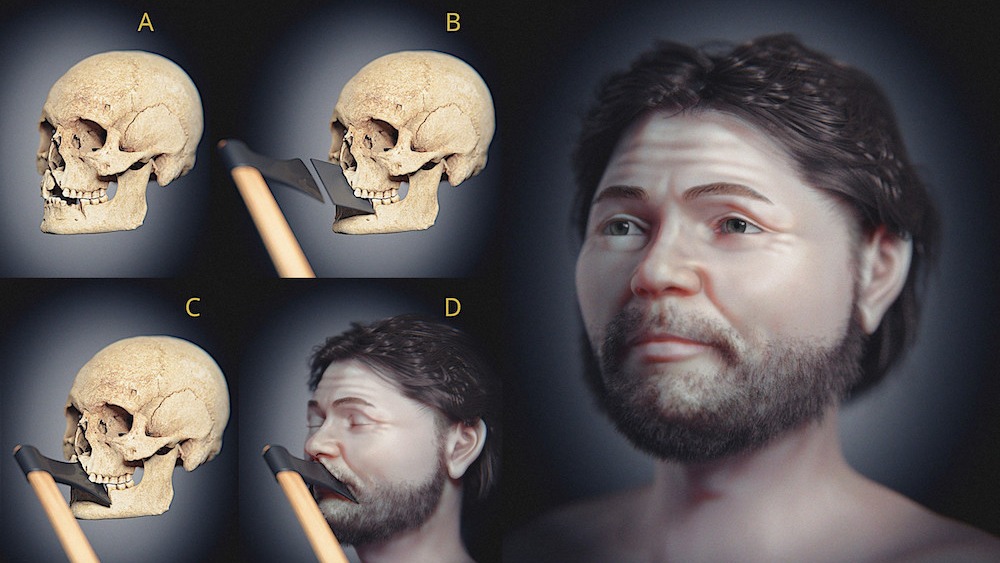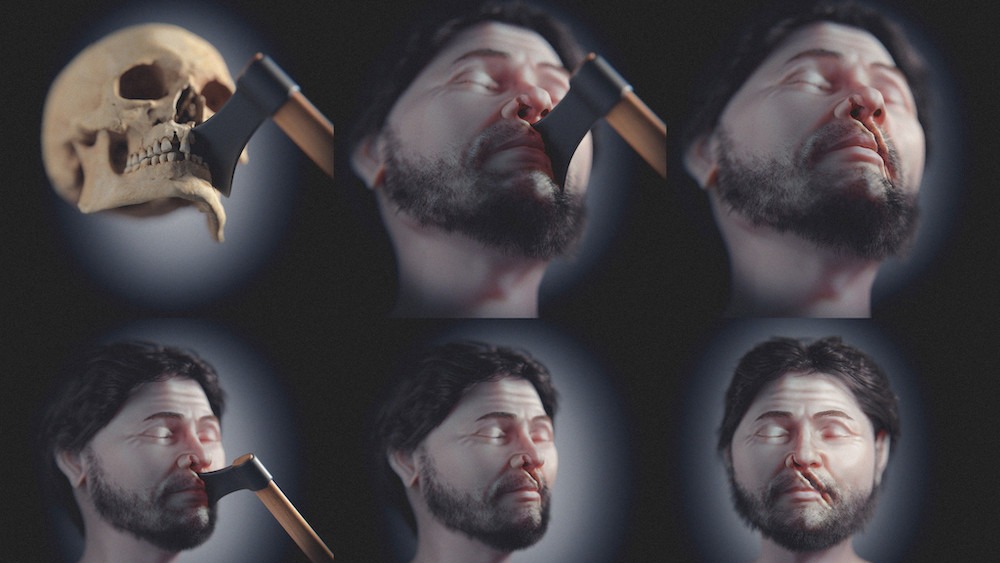Medieval fighter may have died with an ax 'stuck in his face,' reconstruction shows
A facial reconstruction of a medieval skull reveals that the battle victim may have been struck a fatal blow by an ax.

An ax to the face was likely the final blow that killed a medieval combatant during the Battle of Gotland, a blood-soaked attack that unfolded in 1361 between Swedish farmers and the Danish army. Now, more than 660 years later, researchers have released a facial reconstruction showing what this man may have looked like.
The researchers described gruesome details about the unnamed fighter and the ghastly injury that killed him in a new study, published online on Oct. 30. Using a method called photogrammetry, a separate team of archaeologists scanned the human remains that were buried near the makeshift battlefield and published their findings, and one skull in particular caught the attention of lead study author Cícero Moraes, a Brazilian graphics expert, 3D artist and designer.
In the skull, a deep crack stretched diagonally from the bottom-left portion of the lower jaw up to the hollow cavity where the nose once was; several teeth appeared to have been knocked out by the force of the blow, the researchers reported. Such a severe battle wound could have been inflicted only one way: with a powerful ax chop to the face.
"Among the weapon options that could have been used, the ax seemed the most coherent," Moraes told Live Science in an email. "So, I modeled an ax and placed it on the bone. It's hard to know if it killed him, but it certainly did a lot of damage to the soft tissue," Moraes said. "It was shocking to see that ax stuck in his face."
Related: See the striking facial reconstruction of a Paleolithic woman who lived 31,000 years ago
Besides the horrific wound, there's not much known about the man, other than that he was one of 1,800 local farmers who died during The Battle of Gotland, Moraes said. The invasion was led by Denmark's King Valdemar Atterdag (also known as Valdemar IV) who ruled from 1340 to 1375, in a strategic move to gain control over the sparsely populated Swedish island.
"Many [of the] Gotland warriors [were] inexperienced rural militiamen, [and] were massacred by the Danish army, with a cadre mostly composed of well-trained mercenaries," Moraes said in the email. "There were so many dead that most were buried with all their clothing, causing great astonishment to archaeologists who carried out the first excavations."
Get the world’s most fascinating discoveries delivered straight to your inbox.

And the fighter who took an ax to the face wasn't the only one whose remains bore horrific battle wounds. "Many, many of them had pretty nasty injuries to their skulls and legs" that cut deep into their bones, Moraes said.
For the study, Moraes created two digital 3D facial models that approximated what the man may have looked like. In the first, rendered in black and white, the man was in a neutral pose with his eyes closed. The second incorporated a more speculative artistic approach, rendering the man in color and showing him with dark hair, a full beard and a vicious gash extending across the lower portion of his face. According to the paper, the second model is meant to "provide the necessary elements of complete humanization" — an effect that is difficult to convey with shades of gray, Moraes said.
Depicting the gruesome injury with realistic color and details conveys the brutality of war in the distant past and warns of the horrors of war that persist today, Moraes explained.
"I hope people see what a conflict really is," Moraes said in the email. "This facial approximation is a reminder of what happens."
Jennifer Nalewicki is former Live Science staff writer and Salt Lake City-based journalist whose work has been featured in The New York Times, Smithsonian Magazine, Scientific American, Popular Mechanics and more. She covers several science topics from planet Earth to paleontology and archaeology to health and culture. Prior to freelancing, Jennifer held an Editor role at Time Inc. Jennifer has a bachelor's degree in Journalism from The University of Texas at Austin.


